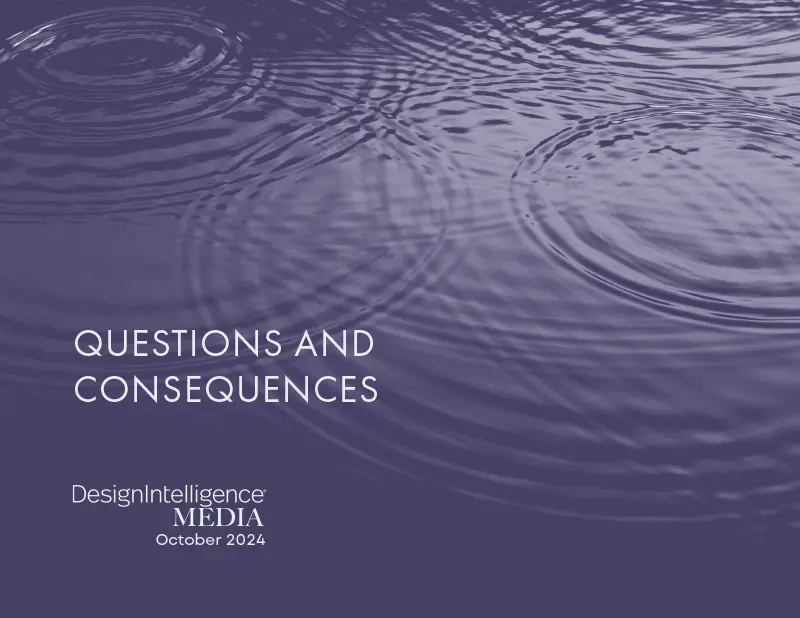
Questions and Consequences
Scott Simpson
Design Futures Council Senior Fellow
October 2, 2024
Scott Simpson reminds us of the value of inquiry and its outcomes.
Design is one of the few endeavors that generates more answers than questions. For any given program or budget, there are always multiple possible solutions. The hard part is not in creating new ideas but in choosing the single best approach among many that should be implemented. The signposts which point in the right direction come in the form of questions. A skillful designer knows that a well-posed question opens the door to new ways of understanding a problem, which in turn leads to better outcomes.
The irony is that the most frequently asked question (“What will it look like?”) is the least useful because it prioritizes appearance over all other factors. Aesthetics are important, to be sure, but they are far from the whole story. What’s more, focusing too closely on a single criterion obscures many other intriguing possibilities. For those who believe “form follows function”, logic suggests that appearance may be the last thing to consider, not the first.
Because design is a journey of discovery, we don’t know how the trip will end before we begin. With so many factors to consider along the way, some known and some unknown, the path forward is fraught with surprises, both good and bad. Like any trip to a new and exotic location, the journey itself can have a profound impact on where things will end. Being open to new perspectives and new approaches fertilizes new ideas, which often can entirely reframe the original question. The more curious we are, the better results we get. It’s a virtuous cycle.
A good designer will always challenge the status quo and look around corners to anticipate the unexpected. A good designer will dig deep to understand the client’s fundamental goals and objectives, especially those not immediately obvious. A good designer will also work without prejudice, allowing the process to play out on its own terms. At the same time, good designers must always be responsive to the inevitable constraints of program, budget, schedule and prevailing codes and standards. It is in the push/pull between the givens and the unknowns where unique solutions reveal themselves.
Properly understood, good design always creates value in excess of cost. In fact, this may be the single most important aspect of what it means to be a designer. Good design breaks new ground, devising different ways of doing things. Value propositions are always multidimensional, not singular. Aesthetics are important as noted above, but in addition to appearance, there are issues of engineering (how things hold together, how a comfortable environment for the occupants is maintained, how much energy is used, etc.) as well as the building’s ability to adapt over time as the needs of the users evolve (and they always do). One huge issue — too often overlooked by clients and architects alike — is the impact of long-term maintenance and operation costs over the project’s useful life. And then there is the ever-present question of ROI: how quickly the investment will provide payback to the owner. There are also larger societal issues to consider, such as the effect of a new project on the environment, where the materials are sourced and the labor involved in delivery. All this makes for a big ball of wax. How are we to make sense of it? A few key questions may offer some guiderails.
The more curious we are, the better results we get. It’s a virtuous cycle.
Why does the world need this project?
Why is it being undertaken in the first place? What are the client’s underlying goals and aspirations, how will they be measured and why are they important? Are there ways other than building something new that would satisfy those goals? While these questions might seem obvious, they are not always directly articulated. It’s important to dig a little deeper to get the full picture.
How will the new project enhance the client’s enterprise value?
Bear in mind that owners build projects to make money, not spend money. Whether they involve new construction or renovation (or both), buildings are an investment. What are the true economic drivers and how are they made manifest? The answers could change dramatically based on the client’s ownership strategy (short-term or long-term).
Owners have many different value propositions. For retail, it’s sales volume. For hospitality, it’s occupancy and rack rates. For colleges and universities, it’s enrollment. For medical centers, it’s ALOS (average length of stay). For performance venues, it’s boosting attendance. For biotech firms, it’s cycle time (how long it takes to bring a new therapeutic drug to market). And so forth.
What are the project’s true life cycle costs?
Most new buildings are in productive service for about 50 years, and over that time, long-term owners will spend far more in maintenance and operations than in the initial capital expenditure. Understanding the overall life cycle costs up front will enable designers to make much better decisions when selecting structural and MEP systems, devising circulation patterns and in materials selection.
How flexible is the plan?
Most buildings undergo considerable change during their lifetimes. Those changes may be hard to predict, but they will happen. Smart architects understand this and design with change in mind. They know that roofing and the MEP systems will likely be replaced at least two to three times, that there will be occasional need for code upgrades and that new technologies will upend traditional planning norms (just consider the working-from-home phenomenon that has disrupted traditional office design).
What are the project’s social and civic implications?
All buildings exist in relationship to their environments. They have an impact not only on their own occupants but must also be “good architectural citizens” in the civic realm. This greatly expands the notion of who the “stakeholders” are. Such considerations are not always part of the design brief, but they should be.
What are the environmental implications?
Where will the building materials come from? How are they sourced, processed and transported? Who does the work and how are they compensated? What becomes of the construction waste? What kinds of energy systems will be used and what are their near-term and long-term effects? Since about 35% of all construction materials wind up in the dumpster and worldwide construction activity contributes about 45% of all carbon emissions, these important questions have long-lasting impact.
Making buildings is one of the defining characteristics of the human condition. In a very real sense, architecture is how we tell our stories. People are aways trying to find ways to improve how they live, work and play. To find the best answers, we need to start with the right questions — or face the consequences.
Scott Simpson, FAIA, is a senior fellow of the Design Futures Council and a regular contributor to DesignIntelligence.













